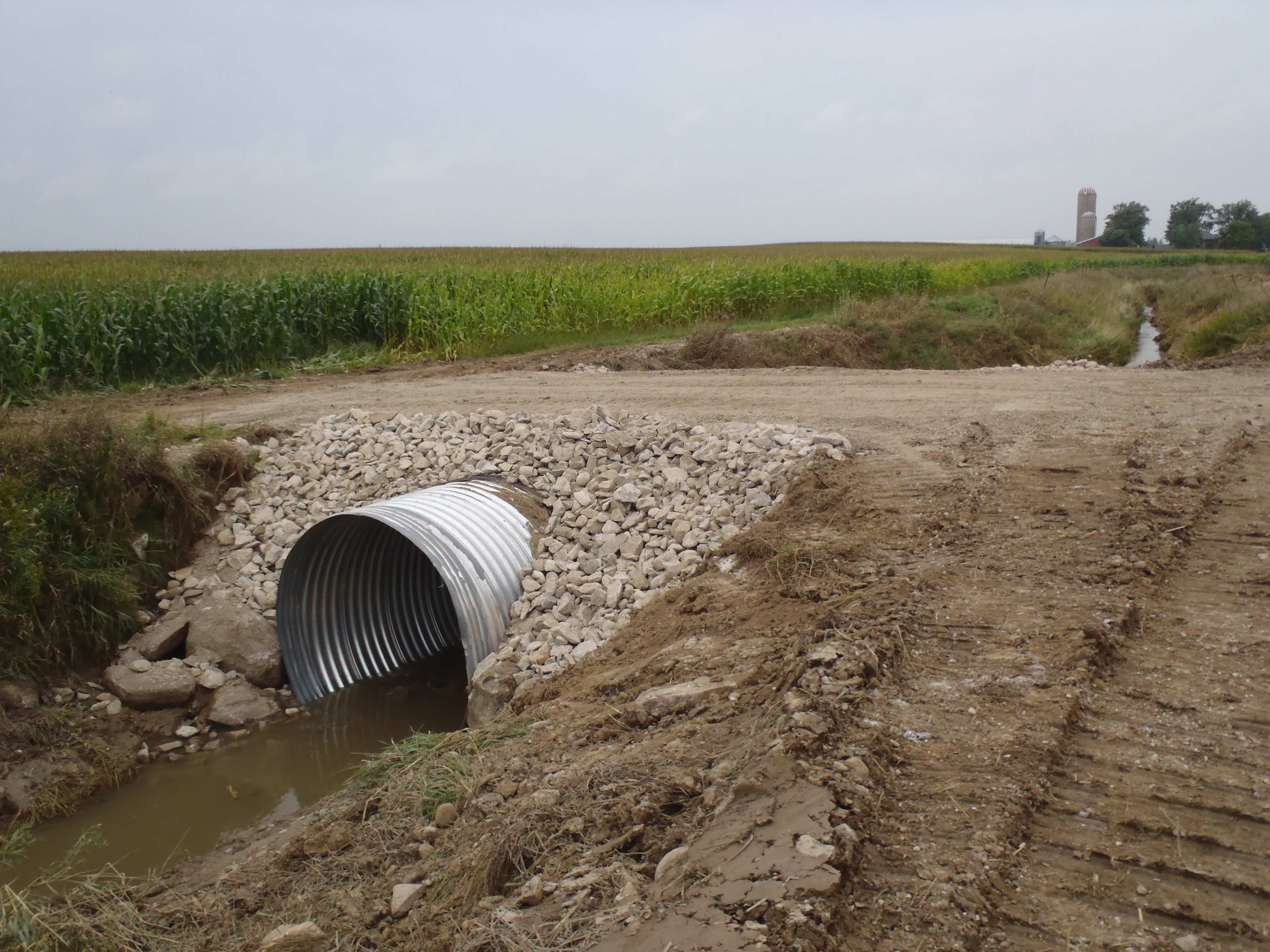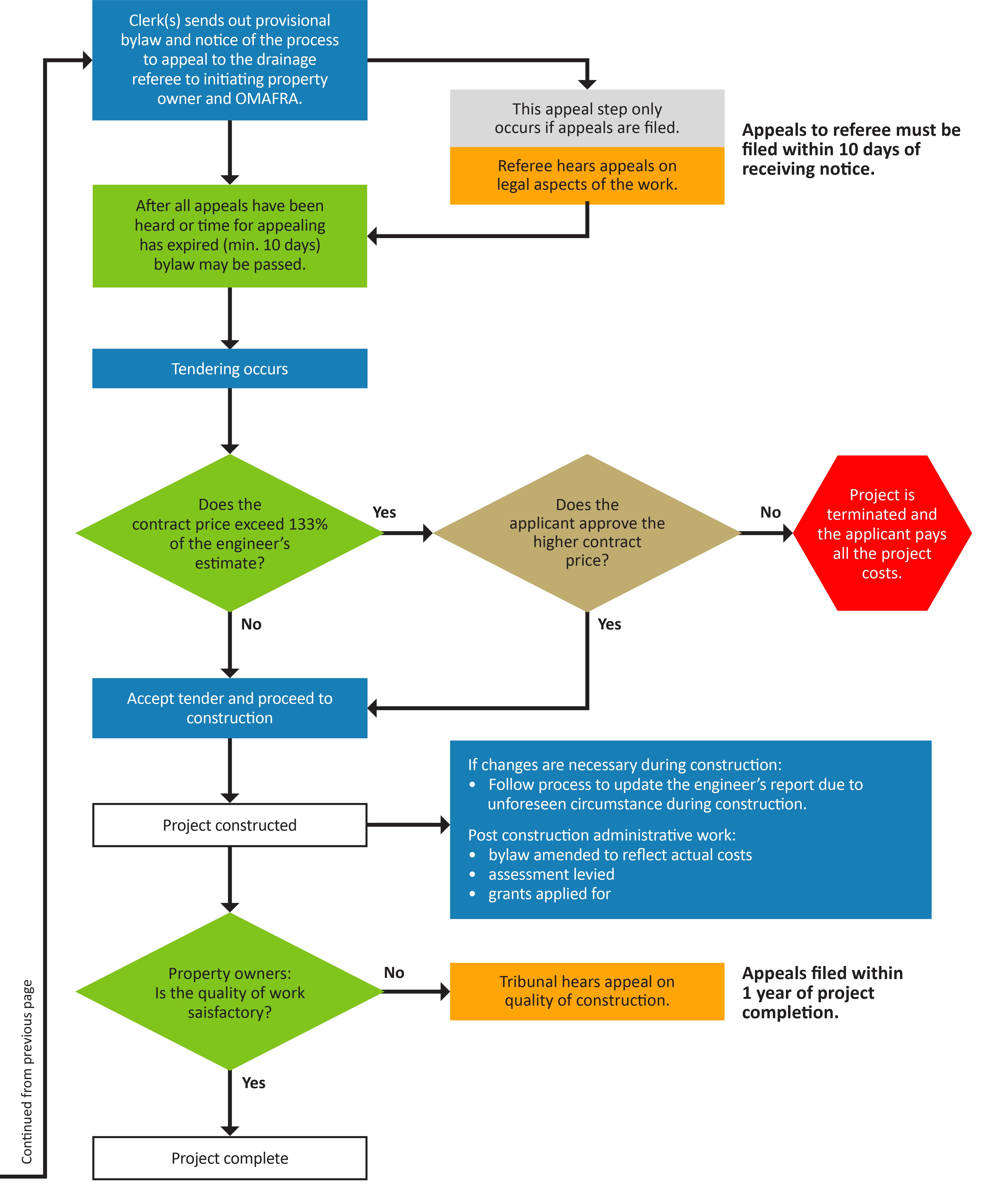Minor improvement projects under the Drainage Act, 1990
Learn when it is necessary to make improvements to the drain because of changes in land use, agricultural practices and technology. This technical information is for municipal staff, drainage engineers and property owners.
ISSN 1198-712X, Published September 2021
Introduction
Drainage systems under the Drainage Act, 1990 are designed and constructed to provide a long service life, especially with maintenance and repair activities completed on the drain. However, there are times when it is necessary to make improvements to the drain because of changes in land use, agricultural practices and technology.
Drain improvements require the creation of a new engineer’s report. Property owners can request their local municipality make improvements to existing drains.
The process to improve a drainage works has been in the Drainage Act, 1990, for quite some time and applies to any changes to the drainage works. The process requires extensive consultation with all property owners in the watershed.
July 2021 changes
Recent changes (July 1, 2021) to the Drainage Act, 1990, have modified the original improvement process. There are now two different types of improvement projects that can be requested under Section 78 of the Drainage Act, 1990, depending on the details of the situation:
- major improvement projects
- minor improvement projects
The major improvement project process is relatively unchanged from the process that existed in the Drainage Act, 1990, prior to June 30, 2021.
The minor improvement project process is new (as of July 1, 2021). It involves changes that are required to address a specific need of one property rather than the entire drainage works. The process is designed to allow projects to be completed in a more timely and cost-effective manner. Examples of minor improvement projects include:
- a farmer requesting a wider crossing to accommodate larger farm equipment
- the addition of a second crossing
- the relocation of a drain on an individual property
- the incorporation of a buffer along a drain
Determining if a project is a minor improvement
A drain project is considered a minor improvement project provided it meets all of the criteria listed in section 7 of O. Reg. 500/21.
The criteria are:
- The project is initiated by the owner of an individual property or two or more adjacent properties that are owned by the same individual or related parties.
- The initiating property owner is paying for all the costs of the project.
- The project does not require access from neighbouring properties, or written consent has been received from the owners of the neighbouring properties. Proof of consent must be provided to the municipality when the project is requested.
- The project will not:
- result in changes to how future repair and maintenance costs are allocated to other property owners in the watershed
- change the drainage capacity or erosion potential
- result in the drain being enclosed
- take place within any wetlands
Did you know? An improvement project for a drainage works that does not meet all the criteria to be considered a minor improvement project is a major improvement project.
Figure 1 shows an example of an improvement project for a drainage works that could be considered a minor improvement project, provided it meets all the criteria for a minor improvement.

Source: Dietrich Engineering Limited, Waterloo, Ontario
Initiation of a minor improvement project
A property owner who is interested in having a drainage project completed on their property as a minor improvement project starts the process by:
- Completing the Notice of Request for Drain Minor Improvement form.
- Sending the form to their local municipality.
The correct form must be used as it is prescribed by O. Reg. 381/12.
The form allows the property owner to describe in detail the proposed work and confirm that the project meets all the criteria for it to be considered a minor improvement project. The form requires documentation showing that permission is granted from adjacent property owners for access during construction, if applicable.
Remember, the property owner requesting the minor improvement project becomes financially responsible for the project costs as soon as their signed request is accepted by the municipal council.
Process for a minor improvement project
1. Initiation
Once initiated by a property owner, municipal council and staff move the project through the process. An overview of the minor improvement project process is provided in Figure 2.
2. Approval
Once a request is received by the local municipality, Council must determine if the request meets the criteria for a minor improvement project. The municipality should also decide if there are other drain improvements needed for the drain beyond the initiating property.
If the municipality determines that all criteria are met and there are no other improvements needed for the drain, then the municipality proceeds with the project as a minor improvement.
If the municipality determines that not all criteria have been met, the municipality must notify the requesting property owner of its decision, including reasons why the project does not meet all criteria for a minor improvement project. If the property owner wants the project to proceed regardless, it will have to proceed as a major improvement project.
Municipal staff send a notice of the minor improvement project to the local conservation authority and other persons prescribed by the regulation. Council appoints an engineer to undertake the project.
Did You Know? A municipal staff person can be appointed as the engineer, provided they meet the definition of “engineer” as defined by section 1 of the Drainage Act, 1990.
3. Engineer’s report
The engineer visits the site and meets with the property owner to confirm the proposed project meets the criteria for a minor improvement project. The engineer notifies the municipality if the project can proceed as a minor improvement project.
Did you know? At the site meeting, the initiating property owner may wish to get an idea of the approximate cost of the project to determine if they should proceed further.
The engineer completes the design of the drain improvement, prepares the final report and files it with the municipality within 180 days of the appointment.
Once the report is filed, within 10 days the municipality must notify the requesting property owner, local conservation authority and other prescribed persons of a council meeting to consider the report. The meeting must be held within 30 days after the report is filed.
Did you know? The engineer’s report should include:
- the design and any plans, profiles and specifications for the minor improvement project
- an estimate of the contract price
- a statement confirming the engineer’s design meets the requirements for a minor improvement project
4. Meeting to consider the engineer’s report
Council holds a meeting to consider the report to ensure the project, as designed by the engineer, still meets the criteria for a minor improvement project.
Input from the requesting property owner, local conservation authority or other prescribed persons is also considered.
At the meeting to consider, the municipal council has three options:
- If changes to the report are necessary, the council can refer the report back to the engineer for modifications and have the report resubmitted to the council.
- If the project as designed, no longer meets the minor improvement project criteria, the requesting property owner is notified and given the option to request the work be completed as a major improvement project.
- Approve the project and pass the provisional by-law to adopt the engineer’s report.
If the council approves the project as a minor improvement project, the municipality sends out a copy of the provisional bylaw and notice of the process to appeal to the Drainage Referee.
Appeals to the Drainage Referee are the only appeals allowed and must be filed within 10 days of receiving the bylaw and notice. After any appeal has been heard or time of appealing has expired, the municipality can pass the final bylaw, authorizing the project, and the tendering process can occur.
Each municipality has its own tendering and procurement policies. However, regulation. O. Reg. 500/21 requires that if the tender price exceeds 133% of the engineer’s estimate, the project cannot proceed to construction unless the applicant approves of the higher project cost. If the applicant does not wish to proceed, the project is terminated and the municipality repeals the bylaw.
Did you know? If at any stage a minor improvement project is terminated, the requesting property owner is required to pay all the costs incurred to date including engineering, construction, contingency and eligible municipal administrative costs.
5. Construction
The processes for construction and post-construction phases for minor improvement projects under the Drainage Act, 1990, are the same as for projects completed as major improvements projects or construction of a new drainage works by petition.
These steps include:
- updating the engineer’s report due to unforeseen circumstances during construction (OMAFRA factsheet Updating an Engineer’s Reports due to Unforeseen Circumstances During Construction), if necessary
- amending the bylaw to reflect actual project costs
- levying the assessment
- applying to OMAFRA for grants, if applicable
- managing any quality of construction issues and appeals under Section 64 of the Drainage Act, 1990


Summary
Minor improvement projects can be a time-saving and cost-effective way for property owners to request improvements to the drain on their specific property without adversely affecting others in the watershed of the drain.
Disclaimer
This fact sheet is provided for informational purposes only to help explain the recent amendments to the Drainage Act, 1990, and the new Minister’s Regulation (Ontario Regulation 500/21) that operationalizes the amendments to the Drainage Act, 1990. Use of this factsheet is at the person’s own risk. If there is a discrepancy between this factsheet and the legislation, the legislation prevails. If you have any questions about the applicability of the Drainage Act, 1990, to your situation, you should consult with a qualified person.
This fact sheet was written by Tim Brook, P.Eng., drainage program coordinator, OMAFRA and reviewed by Andy Kester, drainage inspector and analyst, OMAFRA.